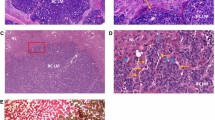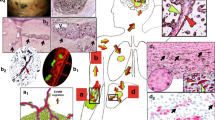Abstract
The existence of tumor cell-lined sinuses (vascular channels) in various experimental and human cancer is known for almost a half a century described by a Hungarian pathologist, Béla Kellner. Meanwhile, even the existence as well as the pathomechanism and the possible functional significance of these sinuses are heavily challenged in the recent literature. Ultrastructural studies however provide evidence for the presence of tumor cell-lined sinuses in human melanoma and breast cancer. The generation of such sinuses can be suggested in two ways: byde novo formation, when tumor cells recapitulate an embryonic geno-and phenotype by reexpressing endothelial genes or by a secondary mechanism, where the incorporated microvessels degenerate due to the predominant expression of anti-angiogenic factors. Literature data are available for the potential diagnostic and clinical significance of the tumor sinuses (vascular channels) stimulating further studies on this issue.
Similar content being viewed by others
References
Folkman J: Tumor angiogenesis: therapeutic implications. N Engl JMed 285:1182–1186, 1971.
Hanahan D, Folkman J: Patterns and emerging mechanisms of the angiogenic switch during tumorigenesis. Cell 86:353–364, 1996
Bergers G, Javaherian K, Folkman J, et al: Effects of angiogenesis inhibitors on multistage carcinogenesis in mice. Science 284:808–812, 1999.
Maniotis AJ, Folberg R, Hess A, et al. Vascular channel formation by human melanoma cells in vivo and in vitro: vasculogenic mimicry. Am J Pathol 155:739–752, 1999.
Folberg R, Hendrix MJ, Maniotis AJ: Vasculogenic mimicry and tumor angiogenesis. Am J Pathol 156:361–381, 2000.
Hendrix MJC, SeftorEA, Seftor REB, et al. Regulation of uveal melanoma interconverted phenotype by hepatocyte growth factor/ scatter factor (HGF/SF). Am J Pathol 152:855–863, 1998.
McDonalds DM, Munn L, Jain RK: Vasculogenic mimicry: how convincing, how novel, and how significant. Am J Pathol 156:383–388, 2000.
Barinaga M: A face-off over tumor blood supply. Science 287:783–785, 2000.
Kellner B: Die Fettmorphologie der Sarkome. Z Krebsforsch 52:240–246, 1941.
Warren BA, Shubik P: The growth of the blood supply to melanoma transplants in the hamster cheek pouch. Lab Invest 15:464–478, 1966.
Radnot M, Antal M: Vessels of intraocular malignant melanomas. Am J Ophthalmol 88:472–478, 1979.
Sato T, Takusagawa K, Asoo N, et al. Ultrastructure of the Lewis lung carcinoma. Eur J Canc Clin Oncol 18:369–376, 1982.
Van Nesselrooij JH, Hendrixen GJ, Feron VJ, et al: Pathogenesis of blood-filled cavities in estrogen-induced anterior pituitary tumors in male Sprague-Dawley rats. Toxicol Pathol 20:71–80, 1992.
Nagano N, Sasaki H, Aoyaki M, et al: Invasion of experimental rat brain tumor: early morphological changes following microinjection of C6 glioma cells. Acta Neuropathol 86:117–125, 1993.
Wesseling P, van der Laak JA, de Leeuw H, et al. Quantitative immunohistological analysis of the microvasculature in untreated human glioblastoma multiforme. Computer-assisted image analysis of whole-tumor sections. J Neurosurg 81:902–909, 1994.
Holmgren L, O’Reilly MS, Folkman J: Dormancy of micrometastases: balanced proliferation and apoptosis in the presence of angiogenesis suppression. Nat Med 1:149–153, 1995.
Pezzella F, Pastorino U, Tagliabue E, et al. Non-small-cell lung carcinoma tumor growth without morphological evidence of neo-angiogenesis. Am J Pathol 151:1417–1423, 1997.
Holash J, Maisonpierre PC, Compton D, et al. Vessel cooption, regression and growth in tumors mediated by angiopoietins and VEGF. Science 284:1994–1998, 1999.
Folberg R, Pe’er J, Gruman LM, et al: The morphologic characteristics of tumor blood vessels as a marker of tumor progression in primary human uveal melanoma: a matched casecontrol study. Hum Pathol 23:1298–1305, 1992.
Folberg R, Fleck M, Mehaffey MG, et al: Mapping prognostically significant vascular patterns in ciliary body and choroidal melanomas. Pathol Oncol Res 2:229–236, 1996.
Bissell MJ: Tumor plasticity allows vasculogenic mimicry, a novel form of angiogenic switch —a rose by any other name? Am J Pathol 155:675–679, 1999.
Author information
Authors and Affiliations
Corresponding author
Rights and permissions
About this article
Cite this article
Tímár, J., Tóth, J. Tumor sinuses - vascular channels. Pathol. Oncol. Res. 6, 83–86 (2000). https://doi.org/10.1007/BF03032354
Received:
Revised:
Accepted:
Issue Date:
DOI: https://doi.org/10.1007/BF03032354




